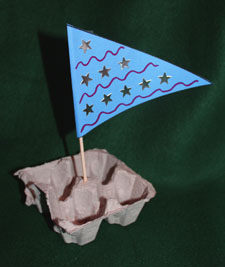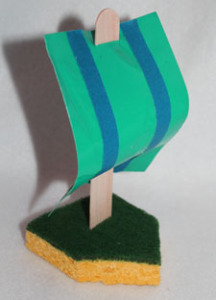
Grgeteg monastery in Serbia
Wikimedia Commons
Most people know that one of the origins of the Santa Claus figure is Saint Nicholas. Fewer people know who St. Nicholas actually was. For non-Orthodox Christians, his feast day is this Saturday, Dec. 6. He is known as the patron saint of sailors, ships, children, pawnbrokers, and prisoners. He is also a patron saint for Austria, Belgium, Germany, Greece, the Alsace-Lorraine region of France, and numerous cities in Italy and the Netherlands. Like most saints, his stories are the stuff of legends. Lucky for us, those legends can easily be turned into fun crafts and activities for kids.
Some details we have about his life are probably historically accurate. He was born around 270 CE to wealthy Christian parents who lived on the southern coast of what is now Turkey. Around 300 CE he became the Bishop of Myra, and in that role, he participated in the Council of Nicaea in 325 CE. Following his death on December 6, 343 CE, St. Nicholas was buried in a Myra cathedral. His remains were found relatively recently, in 1993, on a small island off the coast of Turkey. Beyond that, we have numerous accounts that are surely part truth, part folklore, and part hagiography. The common thread running through these tales is a man known for his compassion, humility, piety, and generosity.
If you want to honor the historical saint with your kids, try making a miter, the tapered headdress worn by bishops. It’s a great craft even for preschoolers. My version is shown below. I simply cut a miter shape from red construction paper and added gold decorations (old-fashioned gold glitter in this case). I then added strips (measuring 1” x 11”) near the base of each side to create the headband. Miter shapes have evolved over the years, and there are innumerable options for decorating them, so you can’t really go wrong. Check out this Kinder-Craze post for another easy Miter Pattern. For slightly older kids, try a Folded Paper Miter.
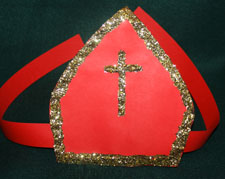
Of course, not all bishops become saints. To be revered as a saint, there must be miracles. Although the official rules for sainthood were established long after St. Nicholas died, he was always venerated for his wondrous deeds, several of which involved the sailors and merchants who were under his jurisdiction. One such story was recorded in The Golden Legend, a compilation of tales about St. Nicholas written by an Archbishop in the 13th century. According to the tale, a group of sailors feared for their lives when their ship got caught in a storm. They prayed for deliverance and were soon joined by an image of Nicholas. He worked alongside them to free the ship. The tempest ceased and he vanished. The sailors then anchored their ship in a safe harbor and hastened to a nearby chapel to offer thanks. There, they encountered the real Nicholas who assured them that all thanks belonged to God. Another story (not recorded in The Golden Legend) speaks of three Christian merchants who were thrown overboard by their non-Christian shipmates. All three prayed to St. Nicholas to save them. The two who could swim were saved by a large stone floating on the waves that carried them to shore. The third, who could not swim, was saved when he was swallowed by a whale. The whale carried him to the stone, and the three merchants were joyfully reunited.
These legends offer great craft ideas for kids since ships are easy to make and come in all sorts of shapes and sizes. Here are two ships that we’ve made. The first one uses a recycled egg carton, a skewer, and some construction paper. The second one uses a scouring sponge, two colors of duct tape, and a large popsicle stick. Younger kids will definitely need help with the cutting, but older kids should be able to complete both boats with minimal supervision. Other ship/boat ideas can be found here.
If you’re in a just-paper kind of mood, I’ve made these origami boats with elementary and middle-school kids many times. If you have trouble visualizing the folds, check out this 3-minute video. These boats are made with any 8½” x 11” piece of paper, which makes for a very short supply list.
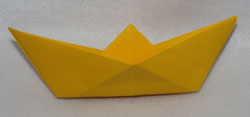
St. Nicholas is also known as the patron saint of children, even though the legends underlying that moniker tend to be both dated and harsh. A common version tells of three children who were lured into the shop of an evil butcher. The butcher slaughtered the children and put their remains in a large tub full of brining salt. St. Nicholas, passing through the region to help the down-trodden, managed to rescue the children, revive them, and return them to their families. Although the story seems to be most popular in France, three English versions are freely available on line (Story 1 , Story 2, Story 3), but you might want to read them first before you decide to share one with your kids.
Although the story does paint St. Nicholas as a protector of children, it’s difficult to imagine how a savage butcher morphed into the Santa Claus we know today. For that, we should probably turn to the more widespread tale, also recounted in The Golden Legend, of the poor man with the three daughters. Since their father was unable to afford a proper dowry, each girl was faced with a grim future of forced labor, spinsterhood, or prostitution. As each daughter came of age, Saint Nicholas anonymously threw a bag of gold coins into the home. In one version, the bag came through a window and fell into a stocking that was hanging to dry. In another version, Saint Nicholas dropped the bag down the chimney and it landed in a stocking drying over the still-smoldering coals. Now we’re getting a bit closer to the Santa tradition.
There are many stocking-related crafts available, but we thought a bag of gold coins would be fun. We made no-sew drawstring bags from a 9” x 9” piece of felt and a length of ribbon measuring about 30”. Small marks were made about an inch from the outside edge of the felt, and the kids made small snips with scissors. The ribbon was woven in and out of the holes using a safety pin attached to one end of the ribbon. Once finished, the safety pin was removed, and the extra ribbon was trimmed off. The gold coins were made by wrapping foil tissue paper around small wooden discs bought at a craft store.
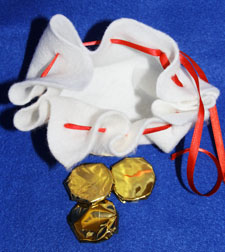
It was clearly a long and windy road from St. Nicholas sharing his 4th century wealth with poor virgins to the jolly Old Saint Nick of today. As you might imagine, additional symbols from the St. Nicholas stories began to crop up. Somehow, the three bags of gold in the story came to be represented as three golden balls, which is the symbol of pawnbrokers. Or maybe the golden-sphere symbol of medieval merchants from Lombard Italy (where pawn shop banking originated) became attributed to St. Nicholas. It’s hard to say which came first at this point, but it still leaves St. Nicholas as the patron saint of pawnbrokers. It gets even murkier when you add in the suggestion that the three golden spheres were later mistaken for oranges which is why there is a tradition of placing oranges in stockings!
At some point, these sorts of traditions take on a life of their own, and those linked to St. Nicholas are no exception. In some parts of the world, the Advent fast is broken on Dec. 6 with a seafood feast. In other parts, stockings or shoes are put out as children hope for a visit from St. Nicholas on the evening of Dec. 5th or the morning of Dec. 6th. For good boys and girls, St. Nicholas leaves a small gift or a sweet treat. In return, children put out a carrot or some hay for St. Nicholas’ horse.
At the heart of those traditions are the stories, told long ago and far away, about a big-hearted priest. St. Nicholas was surely known for his charity, but he was also known for deflecting admiration. It’s a saintly combination of traits that can be difficult for the rest of us to master, especially this time of the year. The gratitude that was Thanksgiving is already beginning to wear off as we all gear up for the Christmas holidays. Advertisements abound as lists are made and shopping becomes frantic. Sharing a message of generosity coupled with humility with your kids is probably not a bad idea right about now. I suspect that most of us adults could find a reminder or two for ourselves in those stories, as well.
Additional Sources
The most extensive site, by far, on St. Nicholas is here. If you click on the “For Kids” box, you will find all sorts of interactive games, craft ideas, and stories to round out your St. Nicholas celebration.
For more information about the history and legend of St. Nicholas, click here.
